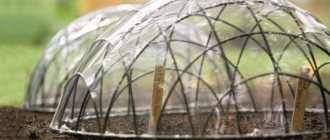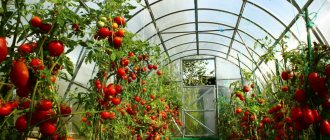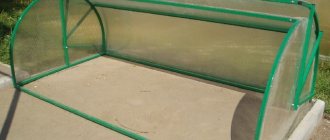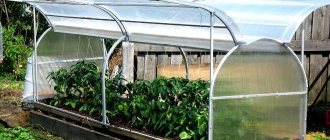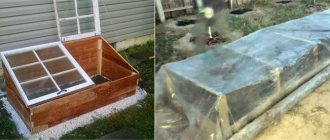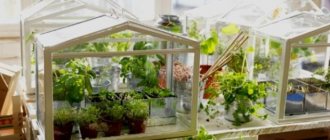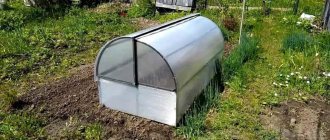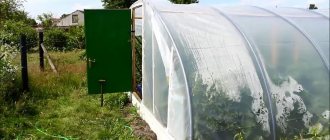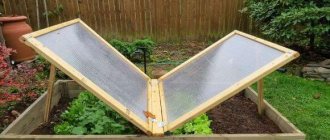Greenhouse / Types of greenhouses
Photo of a simple greenhouse made by yourself.
Nothing can please a summer resident more than a good harvest in his garden beds. How, from what material and where is it better to install a greenhouse for growing tomatoes on your own dacha plot.
- 1 Advantage of a greenhouse
- 2 How to choose a location for a greenhouse
- 3 Materials for the greenhouse frame
- 4 Installation of the frame base of a greenhouse for tomatoes 4.1 Consider a more durable triangular one (like a house)
- 4.2 Greenhouse for tomatoes from old window frames
Criteria for choosing a greenhouse structure
There are several criteria for choosing a greenhouse design. Let's look at each of them.
- Choice of material. Greenhouses can be film, polycarbonate or glass. The best option for tomatoes is a polycarbonate structure.
- Installation method. The best option is a simple design with the possibility of repeated disassembly and installation.
- Construction of the building. The greenhouse can have any shape, but it is better to choose a simple one.
- Size . The greenhouse should not take up much space on the site, but at the same time it is better to select the size of the building not end-to-end, but with a reserve, because over time the number of tomatoes may increase.
- The frame of the greenhouse must be made of steel or aluminum . Aluminum is the preferred option as it does not rust.
Materials used
Ideally, new building materials are used. But if you lack money or are unable to buy what you need, you can build a greenhouse from scrap materials. It all depends on the construction skills of the summer resident, the availability of the necessary tools, and a clear understanding of what the final object should look like. Mandatory minimum that a gardener must have before construction:
- roulette;
- building level;
- hammer;
- wire cutters;
- Screwdriver Set;
- scissors or knife;
- pliers;
- drill and screwdriver;
- grinder or saw (both for metal and wood);
- welding (in case of iron construction).
A set of such tools will help avoid delays in construction and make the process as productive as possible.
For a visual example, you can print out several photos of the finished project and make a drawing with all the dimensions.
The following materials are required for the frame and base:
- bricks;
- cement;
- construction adhesive;
- scotch;
- nails, staples, bolts, screws;
- plastic or metal-plastic pipes;
- concrete (grape) columns;
- wooden boards, slats, planks, beams of various sizes;
- metallic profile;
- galvanized or other metal pipes.
For coating use:
- polycarbonate;
- greenhouse film;
- agrofibre.
Greenhouse equipment for growing tomatoes
It is important not only to choose the right greenhouse structure, but also to create favorable conditions for growing plants.
Lighting requirements
Tomatoes have high requirements for lighting levels. You need to think about it even before planting plants in the ground. If there is not enough light in the greenhouse, it is necessary to plant tomatoes at a large distance so that they do not shade each other.
Greenhouse heating
To grow tomatoes year-round, you need to install a greenhouse heating system. It can be electric, steam, air or gas. The cheapest method is stove heating. In this case, a boiler is installed that is heated with wood. Installing gas heating requires constant ventilation, and the electric method of maintaining the optimal temperature in the greenhouse will not be cheap.
Irrigation system
The optimal system for watering tomatoes is drip. You can run drippers to each plant or use drip tape. If you install special controllers, watering will be adjusted automatically.
Ventilation
It is necessary to provide high-quality ventilation in the greenhouse, so it is recommended to make several wide windows in the structure. This will save the tomatoes from the heat and from pollen sterility. It is better to place the vents at the top and bottom of the greenhouse.
Harvesting
Some varieties of tomatoes can be harvested as early as early summer. Once the plant is ripe, it will not last very long. It’s better to act according to the bed-table principle. It is necessary to ensure that the tomatoes do not overripe. Firstly, they quickly deteriorate, and secondly, the product loses its beneficial properties.
The fruits can be picked unripe (brown) - they will “arrive” in a week. Vegetables are most often collected in this way for canning or transportation. If there are prerequisites for frost in the fall, it is better to pick the fruits green. There are many recipes for canning them in this form.
The fruits can be collected both ripe and in “green” form. They'll be done in a week.
The best varieties for growing indoors
The best varieties of tomatoes for growing in a greenhouse have the highest yields, taste, and disease resistance.
| Variety name | Main characteristics | Fruit quality | Resistance to diseases and pests |
| "Honey spas" | Medium ripening period, salad variety | The fruits are tasty, yellow, large | Resistant to cracking and disease |
| "Mushroom basket" (Fungus sporta) | Indeterminate variety, bush height 2.5 m | The fruits are large, red, ribbed | Average disease resistance |
| "Black Moor" (Nigrum μαῦρον) | Bush height 1.3 m | The fruits are round, smooth, chocolate-red color | Average disease resistance |
| "Pink Leader" (Rosea dux) | Early ripening variety, early ripening period, bush height – up to 1 m | The fruits are red, sweetish | Average disease resistance |
| "Fontanka" | Early ripening variety, bush up to 50 cm high | The fruits are red, you can collect up to 45 pieces from a bush | Good disease resistance |
| "Summer resident" (Cottager) | Low bush - up to 50 cm | The fruits are red, round, small | Good frost resistance |
| "Cardinal" | The bush reaches a height of up to 170 cm | The fruits are pleasant to the taste, raspberry-colored, the pulp is juicy | Average disease resistance |
| “Russian soul” (Russian anima) | The bush reaches a height of 1.5 m | The fruits are red, large, can be used for salads and canning | Average disease resistance |
| "Monomakh's Cap" (Pilleum Monomakh) | A productive variety, per square meter. m you can collect up to 14 kg of tomatoes | The fruits are tasty and aromatic | Good disease resistance |
| "Canadian gigas" | The plant is tall - up to 1.5 m | The fruits are slightly flattened, large, with sourness | Good disease resistance |
Formation of standing density ↑
For proper operation of polycarbonate greenhouses with full equipment (heat, moisture, lighting, nutrient soil, etc.), it is better to grow tomatoes of tall indeterminate varieties and form them into one stem. With a single-stem form, the distance between the bushes can be 30 cm; it is optimal to leave 50 cm between the rows. When planting in rows (in 2 rows), it is better to plant seedlings or sow in holes in a checkerboard pattern. This technology will make it possible to better use the greenhouse space and plant more plant bushes.
Rational arrangement of beds
Tall varieties, formed into several stems, can be planted in one or two rows, being sure to follow a checkerboard pattern. The gap between bushes is 45-70 cm, between rows 70-80 cm.
In small greenhouses with a different coating (reinforced film, regular double film, bubble film, etc.), large yields are produced by low-growing determinate varieties. They are formed in a bush-like manner with 2 or 3 stems, sometimes they are not planted at all. In such conditions, it is more advisable to grow early ripening varieties. Planting can be done in 2 rows, observing a checkerboard pattern. The free space in a row is 40 cm, between rows is 50-60 cm.
If greenhouse conditions allow, you can combine several varieties of tomatoes of different types. In this case, the outer beds are occupied by low-growing tomatoes, and the central bed with the highest distance to the ceiling is occupied by indeterminate tomatoes. This technology will make it possible to provide the family with fresh vegetables for a longer period.
Planting tomatoes in a greenhouse
Tomatoes are a well-known and ubiquitous vegetable crop. Gardeners often encounter problems growing it. Let's take a closer look at the technology of planting tomato seeds.
Seed preparation
Tomato seeds can be planted either dry or after soaking. Pre-soaked material germinates faster. Before sowing, the seeds must be carefully sorted and all defective (empty) ones must be thrown away. You can identify empty seeds as follows: place all the seeds in a saline solution for 15 minutes; those that float to the top are not suitable for sowing. The rest should be washed with running water and can be sown.
Soaking the seeds is carried out as follows:
- Place a wet napkin on a plate with seeds on top.
- To prevent the water from evaporating, cover the container with a lid and leave everything for a day.
- Seeds that have swelled can be planted.
Soil preparation
Several types of soil are suitable for growing tomatoes. This can be turf and humus soil or a purchased mixture. The soil for seedlings should be loose and light; peat and sawdust will help achieve this consistency.
Planting dates and scheme
The best time to grow seedlings is mid-March. Seeds should be planted in shallow holes and sprinkled with soil on top. Seed germination in a greenhouse depends on the tomato variety and temperature. At 20 degrees Celsius, seedlings appear in 15 days.
Only fifty-day-old seedlings can be planted in an unheated greenhouse. Such plants are about 30 cm high and have 7-8 leaves.
Types of greenhouses and their construction
There are many types of greenhouses for tomatoes. Videos, as well as advice from knowledgeable people, will help you understand how to make them correctly.
Express greenhouse
Even those summer residents who do not have serious construction skills can cope with the construction of such a greenhouse for tomatoes “in a hurry.” This option can be easily made from wooden bars or the same window frames, placing them in a house and fastening them together. A greenhouse film is stretched over the top, after which you can safely plant the plants. True, such a structure is more suitable for tomato seedlings.
From window frames
Old window frames are ready-made blocks for building a greenhouse for tomatoes. The best option would be to lay a brick foundation on which the frame itself will be installed. Sometimes the foundation is a thick wooden beam, necessarily treated with an antiseptic.
The frames are installed vertically, secured to each other with self-tapping screws and connecting angles. The top of the frame is connected to a solid wooden beam. Moreover, the frames can be used both with and without glass. To enhance the strength and safety of the glass, it is recommended to glue it crosswise with regular tape.
Triangular
Such greenhouses, in addition to benefits, also bring aesthetic pleasure - thanks to their unusual triangular shape, they decorate the garden plot. The height allows you to grow even the tallest varieties of tomatoes. For construction use:
- wooden boards;
- beams;
- metal profile;
- pipes.
Thanks to its shape, the greenhouse can easily withstand even the heaviest snowfalls.
Folding
This type of greenhouse for tomatoes is also called a “butterfly greenhouse”. It is suitable for growing both seedlings and low-growing tomatoes.
An important advantage of such a structure is that, thanks to the wings that rise upward, ideal ventilation is ensured.
Greenhouses-bread bins
This is a convenient, compact and mobile version of a greenhouse. It is mainly used when growing seedlings. Due to the small height, tall and powerful bushes simply will not fit there. There are no clear standards for construction, but usually the length of such a structure is 2-4 m and the height no more than 1 m.
The width is chosen depending on the crop chosen for planting, the availability of free space, and the materials from which the construction is planned. This mini-greenhouse really resembles a large bread bin. It consists of 2 halves and doors that move up and down on hinges. This design makes it easier to care for plants and allows you to regulate the microclimate.
But more often, summer residents build a simple single-leaf version. For construction, galvanized pipes (with a diameter of 20 mm) or metal profiles are taken; strong plastic pipes are also suitable. It is advisable to cover such a greenhouse with polycarbonate, but greenhouse film or dense agrofibre is also used (in the south).
Arched
A greenhouse made of arcs with covering material will become a reliable assistant for the gardener. It is suitable for tomato seedlings and full-fledged fruit-bearing bushes. Even an inexperienced summer resident can make such a low greenhouse for tomatoes with his own hands without straining.
They use plastic, metal-plastic, galvanized, painted metal pipes, thick wire, fittings and even willow branches. They are bent, then the arcs are placed at a distance of 40 to 60 cm, and their ends are sunk into the ground by 10-15 cm. Afterwards, film or agrofibre is pulled over them.
Single-pitch
Roughly speaking, this is a gable greenhouse for tomatoes, divided in half exactly in the middle. The slope of the roof goes in one direction, and the back wall turns out to be flat; usually there are vents in it for ventilation.
For construction, you can use wooden beams, slats, boards, metal profiles, iron pipes. This greenhouse is suitable for growing tomatoes for harvest and for seedlings.
Gable
This is the most common option for building a greenhouse for growing tomatoes. But recently, the “greenhouse-house” is quickly losing ground to arched greenhouses.
For construction, any materials are used, including improvised ones. Polycarbonate or greenhouse film is suitable for covering.
A-shaped
This mini greenhouse is great for growing tomato seedlings, as well as low-growing varieties.
The greenhouse consists of two slopes, without side walls, its shape resembles the letter A. Moreover, it can be either deepened into the ground (to preserve heat) or not.
Drops
This greenhouse will become not only functional, but also very beautiful. When building, a project must be drawn up first.
The greenhouse is resistant to heavy snowfalls, winds, and other adverse weather conditions. This is a combination of both arched and gable options. The best covering for a drop greenhouse is high-quality cellular polycarbonate.
Made of metal
When building greenhouses made of metal, it is important to pay great attention to its quality and thickness. Thin, cheap metal will quickly rot. Therefore, the ideal option is to make a greenhouse for tomatoes from galvanized pipes. This is the best material for building any greenhouse.
Wall mounted
Usually this is a lean-to greenhouse adjacent to another, preferably permanent, building. Such a greenhouse is attached to a house or other outbuildings. It is adjacent to one of the supporting walls, significantly reducing the cost of constructing the frame.
The shape of the roof can be either straight or curved. Used as a nursery or a full-fledged greenhouse.
Features of caring for greenhouse tomatoes
As soon as the first shoots emerge, they should be provided with proper care. This is the only way you will get a good harvest.
Features of watering
Watering the seeds should be minimal, otherwise the tomato sprouts will quickly rot. When the first leaves appear, watering can be made more frequent - up to once every five days. If the soil is dry, it is necessary to periodically spray it with water. Adult tomatoes are watered rarely, but abundantly.
How to fertilize
It is better to fertilize the soil in the fall. If the soil is peaty, you should add well-decomposed compost or sand to it. The majority (60%) should be peat, sand and compost should be 20% each. For loamy soil, more compost needs to be added, up to 50%.
During autumn digging, 500-800 g of ammonium nitrate, 3-4 kg of ash and the same amount of superphosphate per cubic meter of soil are added to the soil.
If fertilizers have not been applied since the fall, you can add complex fertilizer and ash to the hole before planting the seedlings. Take about 3 tablespoons of fertilizer and about half a glass of ash. Then each hole must be thoroughly watered - about 5 liters of water per hole will be required.
Formation of tomato bushes
The formation of a tomato bush is carried out by pinching, which involves removing excess shoots in the leaf axils and pinching the top. The procedure is necessary to prevent tomatoes from growing. Low-growing tomatoes do not need to be pinched; only tall varieties are subject to this operation!
Stepchildren are called shoots that form in the axils between the leaves and the main stem (on which the first flower cluster has formed). These shoots are eliminated when they reach a length of 7 cm. The first time the stepsons are removed 2 weeks after planting the seedlings. Repeat the procedure at intervals of 12 days.
Tying tomatoes
To tie tomatoes, you will need stakes or rods, wide garter material and wire. It is better to use fabric 3 cm wide as a garter material. Nylon tights or knee socks are often used. You can purchase special plastic devices for garters - they are reusable and will last more than one season. The tying process is very simple - a stake is placed next to the tomato, which is attached to a wire to the wall or roof of the greenhouse. The plant is attached to the stake with garter material.
How to normalize ovaries
Rationing of tomato ovaries is necessary so that all the fruits have time to ripen in August. If this is not done, tomatoes that have reached technical maturity will not ripen, and the bush may become infected with late blight. The standardization technology is simple - all inflorescences where fruits have not formed are removed. If the embryos on the branch are frozen in development, they are also eliminated.
Protection from pests and diseases
Compliance with the rules of agricultural technology and careful care will protect tomatoes from diseases and pests. Since ventilation in the greenhouse may be insufficient, it is important to carry out preventive work to protect vegetables from late blight (Phytophthora cactorum), mosaic (Alfalfa mosaic), root rot (Radix putrescat), wireworms (Elateridae), cutworm (Polia oleracea L.), greenhouse whitefly (Trialeurodes vaporariorum). Agricultural techniques are used for this:
- room ventilation;
- crop rotation;
- removing diseased leaves;
- weed control.
Chemical methods are also used to protect against diseases:
- spraying plants with copper oxychloride and Bordeaux mixture;
- disinfection of instruments;
- seed dressing;
- change or disinfection of soil.
It is important to note that severe temperature changes contribute to the emergence of diseases. High humidity is also not good for tomatoes.

